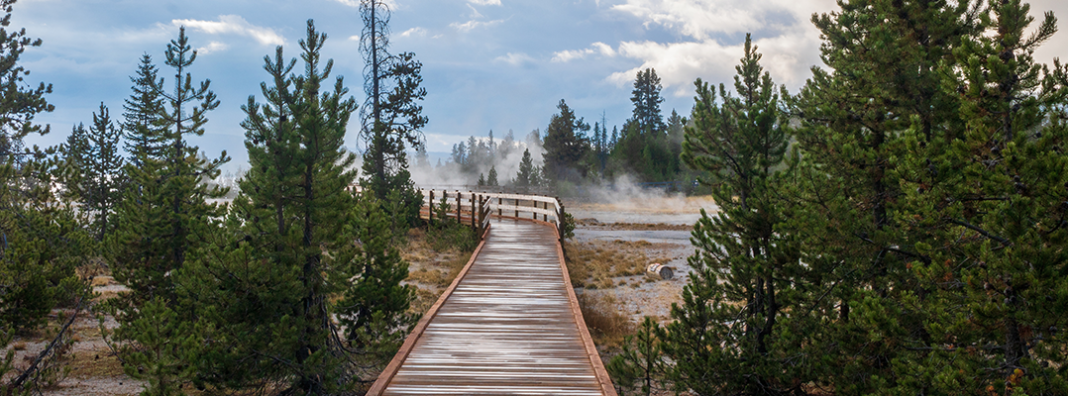
National parks across the U.S. are seeing record-breaking crowds. On the one hand, that’s a huge success. More people than ever are able to see and enjoy the lands and sights. On the other hand, these large crowds present a challenge for the National Park Service (NPS). The dual mission of the NPS aims to both conserve nature and provide recreational opportunities for current and future generations. This creates a paradox: the more people come and enjoy the parks, the greater the human impacts upon them. Yet the NPS must manage human impact carefully to preserve the parks’ natural resources.
National park visitation has steadily increased over recent decades, more than doubling from 1970 to 2019. During this time, the NPS has amassed a $12 billion maintenance backlog. While the Great American Outdoors Act (signed in August 2020) will offset about $6.5 billion of this backlog, a better funding process would allow the NPS to avoid significant backlogs in the first place.
In addition to long lines at park gates, large crowds combined with underfunded infrastructure in national parks may be having negative impacts on the environment. Studies of erosion in Guadalupe Mountains National Park and Great Smoky Mountains show how erosion from trail use and other land disturbances affect the surrounding environment. In protected natural areas, erosion can occur from hiking, camping, biking, and driving and often results in damage to plants, altering soil’s ability to absorb water, and adding excessive sediment to storm run-off. The prolonged government shutdown that began in December 2018 demonstrated, albeit in extreme form, how understaffed and underfunded national parks lead to increased littering and vandalism.
Annual Park Visitation (1970-2019)
Growing crowds mean that NPS employees and infrastructure will become overwhelmed if they are not prepared. This, along with the maintenance backlog and ecological degradation suggest that the NPS needs to rebalance the two parts of its mission. Fortunately, a model for rebalancing these two competing goals can be found in ecotourism.
What can our national parks learn from ecotourism?
The International Ecotourism Society defines ecotourism as “responsible travel to natural areas that conserves the environment, sustains the well-being of the local people, and involves interpretation and education.” Ecotourism emphasizes environmental sustainability over recreation. The principles of ecotourism can help to more closely tie visitors to the conservation of the places they visit, especially through the use of higher visitor fees.
Ecotourism is found all over the world, but one of its biggest champions is Costa Rica. Over the second half of the twentieth century, Costa Rica developed a thriving system of national parks and eco-lodges to protect its pristine wilderness. The Costa Rican government’s tourism bureau issues the “Certificate for Sustainable Tourism” to companies who undergo training and adhere to certain sustainability practices. Academic researchers have examined the Costa Rican ecotourism model and found it to be a source of ecological conservation and economic prosperity. One case study of a Costa Rican eco-lodge found that its 389 hectares (approximately 1.5 square miles) of protected rainforest showed the highest rate of reforestation on the Osa Peninsula. Another study found that ecotourism has diversified the Costa Rican economy and enriched local communities.
A 2015 study looked at another example of ecotourism in national parks in Penang National Park (PNP) in Malaysia. Though this was not an American national park, the researchers found that visitors to PNP preferred a park with strong ecological protections and would be willing to pay a fee if these protections were strengthened (PNP currently has no entry fee). This study highlights one way parks can move towards a model of ecotourism: charging entry fees that reflect the typical cost imposed by each visitor. It also demonstrates how ecotourism can provide an experience that visitors enjoy, even if prices are higher.
U.S. Park fees should be higher
The existence of a large maintenance backlog suggests that fees to enter American national parks are likely far below the actual cost imposed by visitors. Of the 423 sites operated by the NPS, only 108 charge an entrance fee. While the parks that do charge an entry fee tend to be more popular, the fees are still relatively minimal. Studies of both Yellowstone and Yosemite (both of which charge $35 for admission per vehicle for seven days) show that entrance fees account for only 3 percent of a trip’s average total cost. Lodging and food alone accounted for more than 50 percent of the total cost for visitors.
A common concern associated with increasing admission fees is the potential to price out low-income households from visiting parks. This concern can trace its origins back to the mission of the NPS, which is to protect the natural resources of the park for everyone to enjoy. When we understand how little entrance fees are compared to other costs associated with visiting a park, however, we see that a modest increase in entrance fees is unlikely to price anyone out of visiting.
Existing data also shows that low-income households already pay few visits to national parks. In a 2011 study of Yellowstone National Park, only 15 percent of visitors reported a household income below $50,000, which was approximately the national median household income at the time. A similar study of Great Smoky Mountains National Park reported only 24 percent of visitors with a household income below $50,000, when the national median income was $50,303 (though Great Smoky Mountains NP does not charge an entrance fee).
Because most of the cost of maintaining our parks isn’t paid with fees, that means that tax dollars make up the difference. Insufficient entry fees mean requiring taxpayers of all income levels to subsidize the mostly middle-class and wealthy households’ visits to national parks. It is reasonable to ask those using our parks to pay more of the costs that they are imposing. Unlike other government services like Medicaid or the Post Office, national park visitation is a luxury for most. Those who benefit from this luxury ought to bear a greater responsibility for funding them.
Why higher fees will help the parks that we love
Under the Federal Lands Recreation Enhancement Act (FLREA), individual parks keep 80 percent of each entry fee they charge. The rest of the cost of maintaining our parks comes from the U.S. Treasury. In 2020, Yellowstone National Park received $37 million from federal appropriations, while only collecting $15 million from entrance fees. With a total budget of $77 million, this means that visitors to Yellowstone are only paying for 19 percent of the park’s total revenue, while contributions to the U.S. Treasury are paying 48 percent. The remainder of Yellowstone’s revenue comes from donations, concession franchise fees, federal highways, and other reimbursements.
In addition to this, foreign visitors are currently charged the same as domestic visitors, even though they do not pay into the U.S. Treasury with taxes. Increasing entry fees, even by a small amount, would help pay for costs imposed on a park’s natural features and wildlife. Increases in entrance fees for foreign visitors would play a similar role, much like the many state parks that charge more for out-of-state visitors.
Charging more for foreign visitors has wide precedent outside of the United States. Addo Elephant National Park in South Africa, for example, charges $23 a day for foreigners and only $6 for South African citizens. Many of the state parks of both Utah and Maine charge less for in-state visitors than out-of-state visitors for precisely the same reason.
In providing these parks with more revenue, park managers are better able to achieve their conservation goals. Addo Elephant National Park calls its entry fees conservation fees for exactly this reason. The revenues collected from fees allow managers to implement solutions to better manage crowds. Denali and Zion National Parks have installed a bus system, for example, that prevents private vehicles from driving through much of the parks. Higher fee revenues may allow other parks to experiment with similar systems.
Allowing for increased entry fees that better connect individuals with the costs they impose on the park is a first step toward ensuring our parks are preserved for future generations.
Our national parks deserve better
There is something special about national parks, even compared to national monuments and wilderness areas. Economists have found that when a national monument is designated as a national park, visitation increases by over 11,000 people a year.
As national parks groan under the weight of these growing crowds, policymakers need to consider their priorities. A desire to welcome as many visitors as possible is commendable, but being responsible stewards of the environment also means accounting for the costs of visitation.
Crumbling infrastructure allows for human impacts to spill onto the natural features of the park. To mitigate this damage, entry fees should reflect more of the actual cost visitors are imposing on parks. This typically means higher park fees, but at a finer level it will mean giving parks more autonomy to set their own prices. Increased revenue would also allow more parks to innovate with crowd-control measures, like Zion and Denali National Parks have done with their bus systems. The principles of ecotourism show how entry fees can be used to better protect natural resources to preserve our parks for generations to come.


